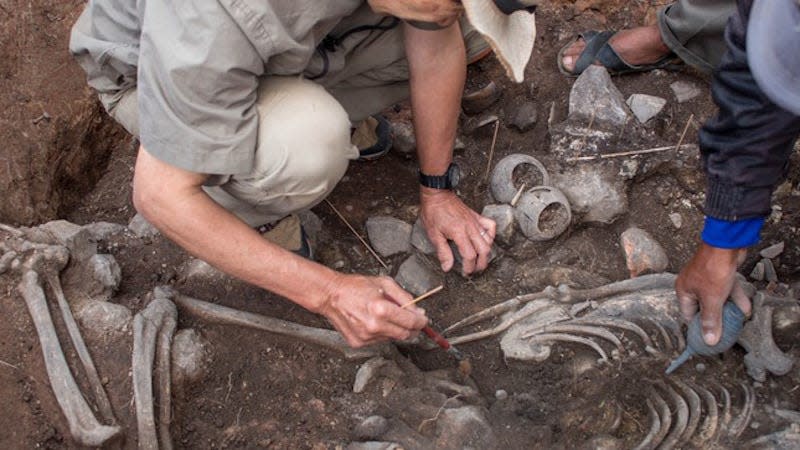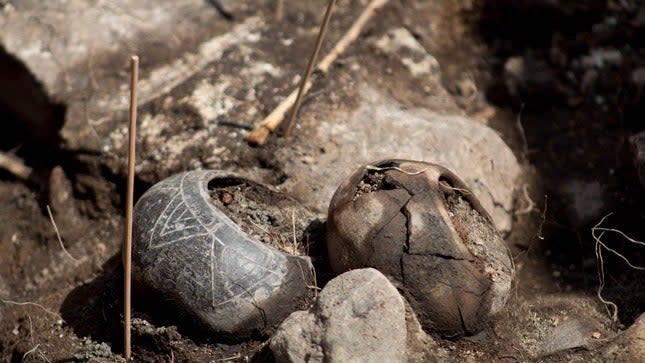Archaeologists in Peru Uncover 3,000-Year-Old Priest's Burial Site

Archaeologists excavating the 3,000-year-old remains.
A team of Japanese and Peruvian archaeologists working in northern Peru’s Cajamarca region have found the 3,000-year-old remains of a man they believe was a priest for the area’s temples.
The individual was found at the Pacopampa archaeological site, about 560 miles (900 kilometers) north of Lima. Pacopampa sits in the Andes mountain range at a lofty altitude of 8,200 feet (2,500 meters). The site was occupied by the Chavín culture, a pre-Inca cultural group that thrived in Peru in the first millennium BCE.
Read more
You Don't Need A Massive Battery, Or Fast Charging To Give Up Gas
Chess World's 'Anal Bead' Cheating Saga Quietly Comes To An End
The Ford F-150 Lobo Could Finally Be Coming To The U.S. As A Performance Pickup
Baldur’s Gate 3 Is Altering Its Ending, Starting With Karlach
The priest’s skeleton was found with small ceramic bowls, a carved bone spatula, and two seals decorated with designs of an anthropomorphic face and a jaguar, according to AFP. The circular tomb containing the body and grave goods was found beneath six layers of earth and ash, and measures 10 feet (3 meters) wide and 3.3 feet (one meter) deep.
“It appears to be an adult and based on observation of the pelvis it appears to be a male, a man,” Seki said in a video published by AFP, in which he crouches in the tomb. “Near the skull, it is broken but there is a bowl or vessel…and apart from this, at the side of the left arm there are two small vessels.”

Two small bowls found among the grave goods.Photo: Ministerio de Cultura
In September 2022, the archaeological team found another priestly tomb containing musical instruments fashioned from conch-like shells. And back in 2015 archaeologists found roughly 2,700-year-old remains of two “Jaguar Serpent” priests. Taken together with the new find, Pacopampa is starting to look like the Chavín equivalent of the Vatican.
In 2017, analysis of 104 individuals that lived in the Pacopampa area between the Middle and Late Formative periods (1200 BCE to 500 BCE) suggested that violence sometimes occurred in the community, with a handful of individuals exhibiting cranial and limb fractures as well as some dislocated limbs. Some of the wounds showed evidence of healing.
The violence is not entirely a surprise, given how metal some parts of pre-Columbian Peruvian culture appeared to be. In 2021, archaeologists discovered a 50-foot mural of a knife-wielding spider god in an ancient ceremonial mound, and last year, a different team found human spines on posts in a 500-year-old burial site.
More digging at Pacopampa will likely yield more information on the culture that inhabited the site several millennia ago. If recent finds are anything to go by, it seems perfectly reasonable to expect more priests to emerge from their ancient tombs.
More: Human Spines Threaded Onto Posts Found at 500-Year-Old Burial Site in Peru
More from Gizmodo
Hailey and Justin Bieber’s Contrasting Outfits Spark Stupidly Intense Internet Debate
Judge dismisses lawsuit against Universal over Ana de Armas not appearing in Yesterday
9 PC Games You Need To Play During Steam’s Latest Strategy Fest Sale
Sign up for Gizmodo's Newsletter. For the latest news, Facebook, Twitter and Instagram.

